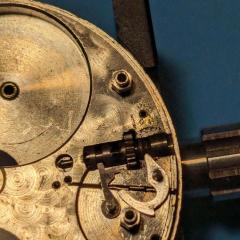-
Recently Browsing
- No registered users viewing this page.
-
Topics
-
Posts
-
By Michael1962 · Posted
I went with GBP as you guys started it off and $4.04 adjusted for inflation. -
Great help for me - thank you all. If the hairspring has been shortened, it must have have even tighter coils than it does now and they all look utterly concentric but nevertheless I'm not leaning further towards that explanation. For me, vibrating a new hairspring would be far from easy - I wouldn't know where to start.And if a new contrate wheel has been cut and mounted, it's been done very skilfully, leaving no obvious telltale signs. Cutting and crossing out contrate wheels takes skill, too, so a bit of a last resort. and why would the he have cut 70 teeth if the existing one had 75. The platform certainly looks original to the clock but I cannot rule out the possibility that it has been taken from a similar period one (with a different tooth count). It was produced by Soldano (who supplied Dent) and the movement is by Hollingue Freres (who worked for Drocourt) so it's a nice small one (not a miniature) but I have to say that it does look like it has been worked on by someone with a hammer and centre punch instead of a bushing tool. The history isn't know - the current owner has never seen it working. I completely dismantled it again at the weekend to make the tooth count but when I've figured it out, I'll take some photos. But for now, I think I've reached the end of the line.
-
Thank you for your introduction and welcome to this friendly forum. We all look forward to your contributions and continued involvement. You might find this helpful. 704789946_TZIllustratedGlossary(2).pdf
-
By RichardHarris123 · Posted
My dad was a printer, they used to use ells.








Recommended Posts